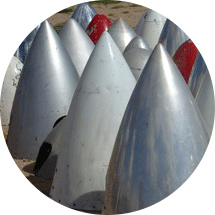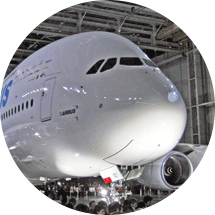Aerospace Component Fabrication
 Winward engineering is well equipped to provide the aerospace industry with the specialist metal spinning, metal pressing, laser cutting, and fabrication that is required for the manufacture of a number of key aircraft components. We boast full traceability of all jobs where required through our comprehensive BS EN ISO 9001:2008 certification for metal spinnings.
Winward engineering is well equipped to provide the aerospace industry with the specialist metal spinning, metal pressing, laser cutting, and fabrication that is required for the manufacture of a number of key aircraft components. We boast full traceability of all jobs where required through our comprehensive BS EN ISO 9001:2008 certification for metal spinnings.
We engineering frequently produces metal spinnings and metal pressings in high-tech materials such as titanium, beryllium, inconel and other special alloys, which are commonplace in the aerospace industry, and is also accustomed to working to very tight tolerances.
We also regularly undertake a number of jobs for aircraft manufacturers – some examples of components that are currently manufactured by Winward include:
Nose Cones, Inlet Cowls and Componentry, Window Fittings, Cabin Fittings, Engine Components, Exhaust Components, Light Fittings, Braking System Components and Landing Gear.
Winward engineering ltd. are pleased to announce continual supply of componentry for Airbus – Beluga and the all new Airbus A380.
Airbus – Beluga featured here. The Beluga (also known as the A300-600ST Super Transporter) was developed to carry complete sections of Airbus aircraft from different production sites around Europe to the final assembly lines in Toulouse or Hamburg. Its main-deck cargo volume is greater than the C5 Galaxy, the An-124 or the C-17 airlifters.
149 firm orders (including 27 freighters) by January 2005. Airbus has forecast a market for approx 1235 airliners of 400 seats and above through to 2020. First deliveries in early 2006.
The 555 seat, double deck Airbus A380 is the most ambitious civil aircraft program yet. When it enters service in March 2006, the A380 will be the world’s largest airliner, easily eclipsing Boeing’s 747.
 Airbus first began studies on a very large 500 seat airliner in the early 1990s. The European manufacturer saw developing a competitor and successor to the Boeing 747 as a strategic play to end Boeing’s dominance of the very large airliner market and round out Airbus’ product line-up. Airbus began engineering development work on such an aircraft, then designated the A3XX
Airbus first began studies on a very large 500 seat airliner in the early 1990s. The European manufacturer saw developing a competitor and successor to the Boeing 747 as a strategic play to end Boeing’s dominance of the very large airliner market and round out Airbus’ product line-up. Airbus began engineering development work on such an aircraft, then designated the A3XX
In June 1994. Airbus studied numerous design configurations for the A3XX and gave serious consideration to a single deck aircraft which would have seated 12 abreast and twin vertical tails. However Airbus settled upon a twin deck configuration, largely because of the significantly lighter structure required. Key design aims include the ability to use existing airport infrastructure with little modifications to the airports, and direct operating costs per seat 15-20% less than those for the 747-400.
With 49% more floor space and only 35% more seating than the previous largest aircraft, Airbus is ensuring wider seats and aisles for more passenger comfort. Using the most advanced technologies, the A380 is also designed to have 10-15% more range, lower fuel burn and emissions, and less noise.
Please note that the above pictures are for illustration only. Not for reproduction, copying or duplication without strict permission from the owner. These pictured do not associate us to the manufacture of any of the finished pictures.





